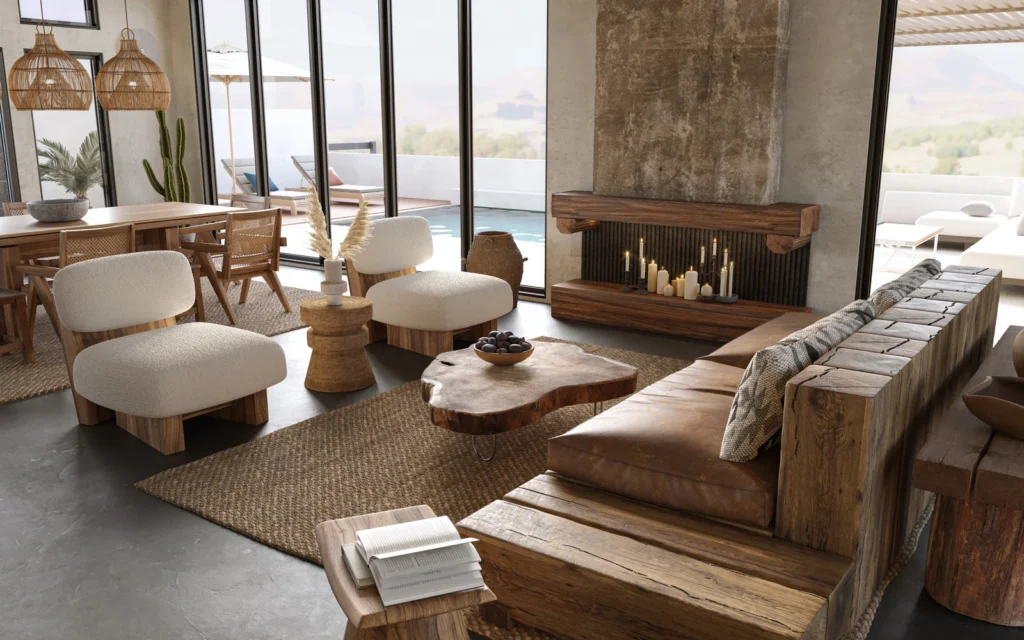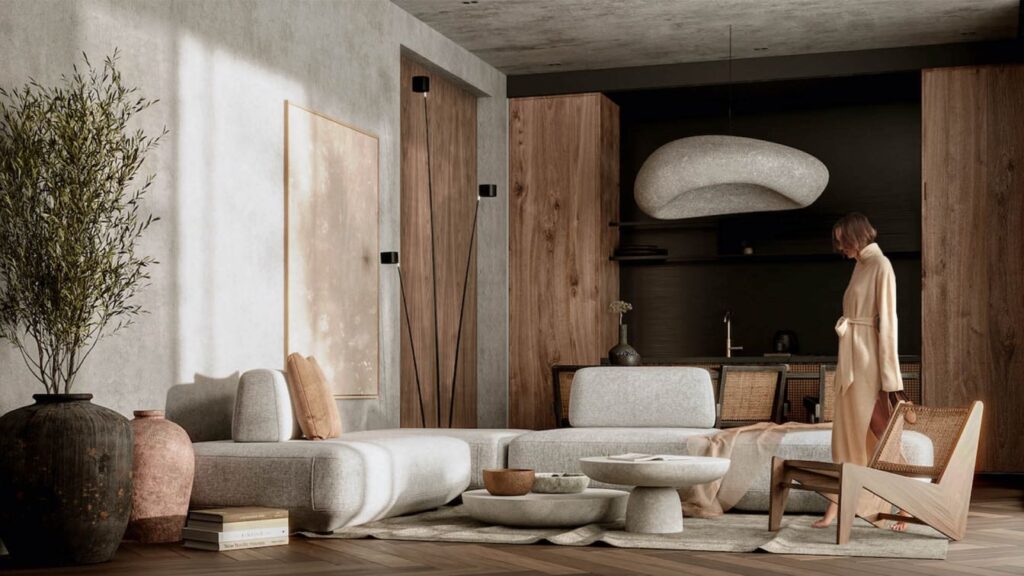The influence of Japanese Wabi-Sabi on modern interior design has gained considerable attention in recent years. This unique Japanese philosophy, which celebrates the beauty of imperfection, simplicity, and the passage of time, is reshaping contemporary spaces. Unlike traditional designs that emphasize polished surfaces and perfection, Wabi-Sabi creates an environment that honors the natural process of aging and the inherent beauty in the imperfect. In this article, we’ll explore how the principles of Wabi-Sabi have influenced modern interior design and how you can incorporate them into your home or office to create a more meaningful and tranquil space.
What is Wabi-Sabi? The Philosophy Behind the Aesthetic
Understanding Wabi-Sabi is key to appreciating its influence on interior design. This Japanese philosophy embraces the natural cycle of growth, decay, and imperfection.
Wabi refers to simplicity and rustic beauty, while Sabi celebrates the beauty found in age and wear. Together, they emphasize the importance of authenticity, nature, and the fleeting beauty of life. In interior design, this means creating spaces that honor natural materials, age, and the imperfections that tell a story.
The Rising Popularity of Wabi-Sabi in Interior Design
The influence of Japanese Wabi-Sabi on modern interior design has surged, especially as people seek refuge from the chaos of modern life. More and more designers are turning to Wabi-Sabi to craft spaces that feel timeless, authentic, and grounded. Instead of relying on shiny, mass-produced furniture, interior design inspired by Wabi-Sabi embraces raw materials, asymmetry, and imperfections, creating rooms that feel both natural and serene.
This growing trend towards Wabi-Sabi in interiors reflects a larger cultural shift toward mindfulness, simplicity, and sustainability. Spaces that incorporate the principles of Wabi-Sabi feel less like “showrooms” and more like living environments that have evolved over time.
Key Ways Wabi-Sabi Influences Modern Interior Design
If you’re wondering how to bring Wabi-Sabi into your own home, the following principles can serve as inspiration. Let’s look at how modern interior design incorporates the philosophy of Wabi-Sabi.
Embrace Natural Materials with Character
One of the primary ways Wabi-Sabi is integrated into modern interiors is through the use of natural materials. Instead of sleek, machine-finished surfaces, designers opt for raw, organic materials that highlight imperfections.
For instance, wooden furniture with visible knots and grain patterns tells a story of the tree’s growth. Similarly, handcrafted ceramics with irregular shapes and textures add an authentic, tactile element to a space. These materials introduce warmth and depth, connecting the interior to nature and the passage of time.
Simplicity Over Clutter: The Power of Minimalism
Minimalism is another key aspect of Wabi-Sabi in modern design. This principle encourages the removal of excess to focus on what truly matters. In a Wabi-Sabi-inspired home, you won’t find overcrowded spaces filled with trendy decorations. Instead, the space emphasizes simplicity and function.
To incorporate this into your design, focus on clean lines, neutral color palettes, and carefully selected pieces that resonate with personal meaning. This minimalist approach fosters a peaceful, uncluttered environment where each item feels intentional.
Asymmetry and Imperfection: Celebrating the Unfinished
Unlike traditional Western design, which often values symmetry and perfect lines, Wabi-Sabi embraces asymmetry and imperfection. This principle is reflected in the furniture, decor, and even the architecture of a space.
For example, a Wabi-Sabi-inspired living room might feature an unevenly shaped coffee table, handwoven rugs with irregular patterns, or walls that are slightly uneven. These imperfections bring a sense of life and movement to the space, making it feel more human and approachable.

The Beauty of Patina and Wear
Wabi-Sabi teaches us to appreciate the beauty that comes with age. Whether it’s an antique leather armchair, a tarnished metal light fixture, or a weathered wood floor, these elements all tell the story of time.
Rather than seeking out brand-new, flawless objects, Wabi-Sabi encourages us to see the charm in worn items that show their history. This creates a space that feels both authentic and grounded, where every object has a story to tell.
Bringing Nature Indoors: Organic Elements in Design
Nature plays a significant role in Wabi-Sabi philosophy, and its influence is felt in modern interior design. Incorporating plants, natural stone, or wood into the decor blurs the line between indoors and outdoors.
Think of a cozy room with large windows overlooking a garden or a Zen-inspired space with a stone sculpture in the corner. These elements create a serene and calming atmosphere, reminding us of the beauty of nature and its constant cycles.
Why Wabi-Sabi Encourages Mindful Living
Adopting Wabi-Sabi in your home isn’t just about creating a visually pleasing environment. It’s also about fostering a mindset of mindfulness and appreciation. By surrounding yourself with items that show wear, age, and imperfection, you cultivate a space that encourages reflection and acceptance.
This philosophy aligns with the growing focus on sustainability and conscious living. As we move away from fast fashion and disposable items, Wabi-Sabi serves as a gentle reminder to value the things we have, cherish their histories, and embrace the beauty in life’s fleeting moments.
Conclusion: A Timeless Aesthetic
The influence of Wabi-Sabi on modern interior design is a celebration of imperfection, simplicity, and nature. By embracing natural materials, asymmetry, and the beauty of age, Wabi-Sabi encourages us to slow down and appreciate the beauty of the present moment.
Incorporating these principles into your home creates a space that feels authentic, timeless, and connected to nature. Whether through weathered wood, raw stone, or minimalist decor, Wabi-Sabi offers a refreshing alternative to the pursuit of perfection. It reminds us that there is beauty in imperfection, and it’s this very beauty that makes our homes feel truly unique.







More Stories
Maithili Thakur: From Folk Singing Sensation to Rising Political Star
Mysuru Dasara: The Royal Festival of Karnataka – History, Culture, and Celebration
Blood Moon Over Sydney: Unveiling the Celestial Show with Telephoto Magic